Gynecomastia surgery offers a transformative solution to a common concern among men. Recovery plays a pivotal role in achieving the best outcomes. Understanding the process and adhering to postoperative instructions are key to a successful journey.
Initial Recovery Days
In the immediate aftermath of gynecomastia surgery, the initial 2-3 days are pivotal for establishing the foundation of healing. Expect sensations of pain, tightness, and tenderness around the chest area. These discomforts can be managed through prescribed pain medication or over-the-counter Tylenol. Numbness may also be experienced due to the surgery, and certain individuals might encounter areas of decreased sensation. While immediate results may be noticed, temporary swelling is common. The use of a compression garment proves beneficial in minimizing both swelling and discomfort, playing a crucial role in the healing process. To aid healing, it’s advised to prioritize rest during this phase, and light walking is recommended to promote circulation. Showering within the first 24 hours is avoided, and specific sleep postures are recommended to facilitate a smoother recovery, often involving sleeping on the back at a 45-degree angle.
Progressing Through Week One
As the first week unfolds after gynecomastia surgery, patients experience a noticeable reduction in pain and swelling. The initial discomfort begins to subside, allowing many to return to work and engage in light activities. However, caution remains necessary, with strenuous actions that involve the chest muscles still off-limits until surgeon clearance. During this phase, stitches might be removed, while the consistent use of compression garments continues to aid in minimizing discomfort and facilitating proper healing. As the days pass, sleeping positions often improve, allowing for more comfortable nights, even though side or stomach sleeping may still be advised against. The patient is gradually transitioning towards a greater sense of normalcy while diligently adhering to the recovery process’s requirements.
Nearing the Second Week
As you approach the second week of gynecomastia surgery recovery, progress becomes increasingly evident. The initial discomfort and tightness begin to subside, allowing you to engage in a broader range of activities. During this phase, the focus shifts towards regaining a sense of normalcy. Returning to work and performing light activities becomes more manageable, though caution is still advised when it comes to strenuous movements that involve the chest muscles. It’s an encouraging phase where you might notice a decrease in pain, and your overall energy levels may improve. With swelling gradually diminishing, you’ll start to gain glimpses of the final results that the procedure has set in motion.
Approaching the One-Month Mark
As you near the one-month milestone after gynecomastia surgery, a notable shift occurs in your recovery. The initial discomfort has subsided, and you’ll find yourself progressively engaging in more daily activities. This phase often sees a return to a broader range of tasks and exercises. The initial restrictions on strenuous activities are lifted, allowing you to venture into a more active routine. Your body is adapting to its new contours, with swelling and bruising giving way to a clearer glimpse of your final results. Compression garments, once essential, may now be set aside, marking a significant step forward. Bathing becomes a routine, unveiling the progress made in reducing bruising and revealing a smoother chest appearance.
Crossing the Six-Week Milestone
In the six-week mark in your gynecomastia surgery recovery, significant strides have likely been made. At this juncture, comprehensive healing is often achieved. Many patients find themselves able to resume all forms of exercise, including activities involving the chest muscles. The once-restricted sleep positions can now be comfortably embraced, offering a sense of normalcy. While some residual swelling may persist, it’s important to remember that this is a natural part of the healing process and is likely to resolve completely within a few more weeks. As you continue to progress, the positive changes in your chest’s appearance become more evident, further reinforcing the journey you’ve embarked upon. Patience and consistency continue to be key as you transition from recovery to enjoying the full results of your gynecomastia surgery.
Managing Pain and Scarring
The management of postoperative pain and scarring is a crucial aspect of gynecomastia surgery recovery. In the initial days following surgery, patients might experience moderate discomfort, which can typically be controlled through prescribed pain medication or over-the-counter options. Scar appearance can vary based on surgical techniques, but skilled surgeons aim to place incisions strategically for minimal visibility. Topical scar treatments and massages can aid in scar tissue softening and fading. While rare, the formation of scar tissue within the treatment area might occur, leading to small lumpy areas on the chest. Vigilance in adhering to postoperative instructions, regular massages, and the use of scar-lightening creams are essential in achieving optimal healing and minimizing scarring concerns.
Keys to Optimal Recovery
Achieving a successful gynecomastia surgery recovery hinges on several crucial factors. Adherence to postoperative instructions forms the cornerstone. Wearing compression garments diligently aids in controlling swelling, supporting the healing process, and facilitating proper skin retraction. Careful fluid intake management is paramount, as excessive intake can contribute to complications like seroma formation. Engaging in tissue massages, particularly during the soft and malleable recovery phase, helps soften scar tissue, ensuring even skin texture. Embracing good posture is both physically and mentally beneficial, fostering confidence and countering the effects of the “gyno hunch.” Gradually reintroducing physical activity while avoiding strenuous chest-specific exercises is key to preventing setbacks and ensuring proper healing. Emotional healing is equally important, with the psychological aspect of recovery addressed through posture improvement and a sense of regained self-assuredness.


